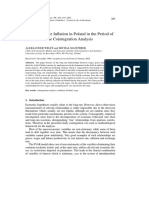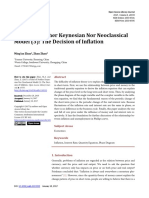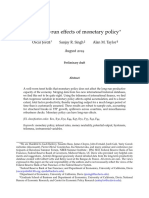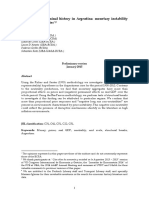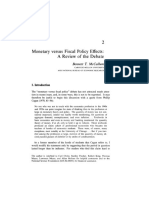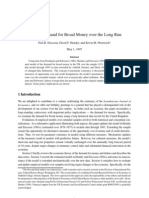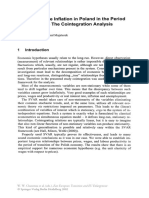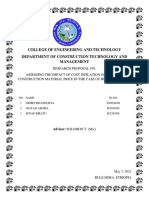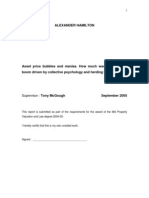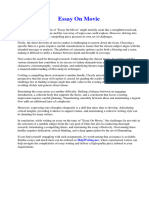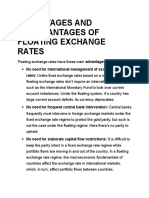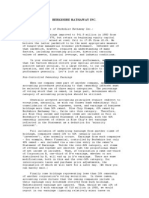Interpreting The Relation of Money, Output AND PRICES IN INDIA (1991:2008)
Uploaded by
Rahul AmrikInterpreting The Relation of Money, Output AND PRICES IN INDIA (1991:2008)
Uploaded by
Rahul AmrikINTERPRETING THE RELATION OF MONEY, OUTPUT
AND PRICES IN INDIA (1991:2008)
Ashutosh Sharma
This study investigates the long-run neutrality of money using monthly data for India for the
post-reform period 1991:1 to 2008:12. Seasonal integration and cointegration methodology have
been applied on both narrow and broad money, real output and prices to test the money neutrality
hypothesis. The empirical results of cointegration showthat both narrowand broad money do effect
real output at seasonal frequencies but at zero frequency, which can be interpreted as the long run,
money does not affect real output. Money is neutral in the long run, but not in the short run. The
cointegration result also confirms that both narrow and broad money affect prices at seasonal as
well as at zero frequency.
I. Introduction
Does money affect real output, or only prices?
The long-run neutrality hypothesis asserts that a
permanent, unexpected change in the level of
money stockwill eventually lead to proportionate
rise in prices and all the real variables would
return to their original values. However, both
Keynesians and Monetarist recognise the effects
of monetary policy on production activities in the
short run, owing to sluggish adjustment of prices
[Mankiw and Romer, 1991]. In other words,
money can be non-neutral in the short-run.
In the money neutrality framework it is
important that the new level of money stock
should be maintained for long period of time,
allowing for long-run neutrality to take place. In
other words, the changes in money stock need to
be permanent if one wishes to test it, in respect of
long-run neutrality. Sargent [1971] and Lucas
[1972] have pointedout that one needs permanent
shocks in money stock within the sample period
to test the long-run neutrality in a time series
framework. A widely accepted measure for
statistically modelling a permanent shock in
economic variables is testing for presence of
integration in the time series. Following this
approach, Fisher and Seater [1993, Pp. 402-415]
had pointed out that if the level of integration of
the level of money stock and other variables (real
or nominal) are equal and at least one then only
one cantest for long-run money neutrality, to find
out if the permanent shocks to the level of money
stock are correlated with the permanent shocks to
other variables. This provides justification that
one canutilise the cointegrationtechnique, which
exploits the level of the series, to help in finding
the long-runequilibriumrelationshipbetweenthe
money and other variables. Examining money
neutrality in a seasonal cointegration setup can
provide us valuable insights regarding the
short-run and long-run effects of money stock on
prices and real output.
Inthisstudy, wefocus ontestingthe neutrality
of money proposition in Indian context.
Empirically, cointegration analysis has been a
popular approach for studying long-run
relationship between money, output and prices.
Following this approach, we analyse the long-run
relationship between nominal and real variables
for the Indian economy. The paper is organised
as follows:
Section II briefly reviews the existing
literature, while Section III presents a
conventional money demand model. Section IV
Ashutosh Sharma, is Ph.D scholar, Department of Economics, University of Mumbai, Mumbai 400 098,
ashuofrabi@gmail.com
Author would like to extend his sincere gratitude to Professor Neeraj Hatekar for his invaluable mentoring and support
throughout this paper. Author also wishes to thank Professor Vikas Chitre (editor of this Journal) and an anonymous referee
of this Journal for several helpful comments and suggestions.
498 JOURNAL OF INDIAN SCHOOL OF POLITICAL ECONOMY JULY-SEPT 2008
presents a seasonal integrated model and
discusses the methodology employed to test
seasonal integration and cointegration in this
paper. In section Vthe data has been reported and
empirical findings of seasonal integration and
cointegration have been presented. Section VI
concludes the paper.
II. Literature Review
The impact of movement of money supply on
output and inflation has been examined
empirically in several important studies using
different methodologies. Fisher andSeater [1993]
employed a bivariate VAR model to test the
long-run neutrality hypothesis using the
Friedman and Schwartz [1982] data on money,
prices, nominal income, and real income from
1867to 1975 in the U.S. The orders of integration
of the variables determine the models
restrictions, while the exogeneity of money is a
necessary condition in their framework. Fisher
and Seater [1993, Pp. 402-415] found that with
respect to nominal income and prices money
neutrality holds in this data, but with respect to
real output, long run money neutrality fails.
In response to Fischer and Seater finding,
Boschen and Otrok [1994, Pp. 1470-1474]
re-estimate the systems studied by Fischer and
Seater, again using the Friedman and Schwartz
[1982] data, but extend the sample period upto
1992. Boschen and Otrok [1994] then split the
data into two periods, 1862-1929 and 1940-1992.
They found that the neutrality of money
hypothesis holds in both sub-samples. They
conclude that there may have been something
special about the financial disruption during the
Great Depression that causes the test failure when
that period is included.
Haug and Lucas [1997, Pp. 756-759] further
commenting on the findings of Fisher and Seater
[1993, Pp. 402-415], postulate that since Canada
did not encounter any bank failures during the
Great Depression, the use of Canadian data to test
the neutrality of money hypothesis might provide
further evidence that something unusual
happened in the US during the years of the Great
Depression. They use a data set that includes real
income and the M
2
measure of money for the
period1914-1994. Using the same bivariate VAR
model employed by Fisher and Seater [1993],
HaugandLucas findthat the hypothesis of money
neutrality cannot be rejected for Canada. They
go on to conclude that this finding is highly
supportive to the arguments put forward by
Boschen and Otrok [1994].
Olekalns [1996, Pp. 393-98] applies the
bivariate VARmodel of Fisher and Seater [1993]
to 94 years of annual Australian data. Olekalns
used the M
1
and M
3
measures of money, along
with real GDP. He found that the neutrality
hypothesis holds when using M
1
, but is rejected
when using the broader measure of money. As
such, Olekalns [1996, Pp. 393-98] concludes that
the results can be sensitive to the measure of
money used.
Coe and Nason [1999] used the Fisher and
Seater [1993] test for long-runneutrality, andthey
employ the same U.S. data as Fisher and Seater,
but updatedthe data through 1997. When Coe and
Nason use a broad measure of the money stock
(as Fisher and Seater did), they replicate the
Fisher and Seater rejection of long-run monetary
neutrality with respect to real output. But when
they replace the broad money measure with the
monetary base, they could no longer reject
long-run neutrality. They also considered data of
about a century from the United Kingdom, and
failed to reject long-run neutrality using either
broad or narrow measures of money. Coe and
Nason conclude that the Fisher and Seater
rejection of long-run neutrality is not robust to a
change in either the measure of money or the
country of study. Coe and Nason also studied the
asymptotic power properties of the Fisher and
Seater long-horizon regression test, and they
VOL. 20 NO. 3 INTERPRETING THE RELATION OF MONEY, OUTPUT AND PRICES IN INDIA 499
conclude that the test has low power against
alternative hypotheses of monetary
nonneutrality.
King and Watson [1992; 1997, Pp. 69-101]
developed another approach for testing the
neutrality of money hypothesis. King andWatson
also used a bivariate VAR model but they also
took careful note of the order of integration of the
variables, in an attempt to analyse the robustness
of their results. Usingquarterlydata for theperiod
1949:1-1990:4, various monetarist hypotheses
about the impact of money on real variables for
the US were tested. King and Watson [1997,
69-101] fond that they could not reject the money
neutrality postulate for the US in the post-war
period.
In Indian context, Ramachandra [1983, Pp.
65-76; 1986, Pp. 98-102] made the first attempt,
in this regard. Using annual data, he found that
money causes real income and price level, price
level causes real income and nominal income
causes money. Nachane and Nadkarni [1985, Pp.
13-41] using causality framework, studied the
relationship between money, output and prices.
Spanning over the period 1960-1961 to
1981-1982 using quarterly data, their results
suggest the presence of unidirectional causality
from money stock to prices. Rao and Bajpai
[1995] have examined the stability of long run
and short run demand for money function for the
time period 1952-1953 to 1990-1991 and found
that there exists a stable long and short run
relationship between broad money, output, and
prices. Ramachandran [2004, Pp. 983-1001]
using annual data for the period 1952-1953 to
2000-2001 has found that a stable long run
relationship between M
3
money, real gross
domestic product and wholesale price index,
exists in India.
Moosa [1997, Pp. 139-155] using a seasonal
cointegration framework tested a sample of 76
quarterlyobservations coveringtheperiod1972:1
to 1990:4. The variables he considered are money
supply proxied by currency in circulation, output
was proxiedbyIIPgeneral IndexandWPI general
Index was taken as proxy for price level. Moosa
[1997, Pp. 139-155] applied Hylleberg et al.,
[1990, Pp. 215-238] unit roots test followed by
Engle et al., [1993, Pp. 257-298] test for seasonal
cointegration. In his study, the results of the
seasonal cointegration test show that money and
output were integrated only at the biannual
frequency which corresponds to a six monthly
cycle (two cycles per year), a within year
phenomenon. However, no cointegration was
found at the zero frequency (The cycle of zero
frequency corresponds to a cycle that never
repeats itself), or the long-term trend. Moosa
based on these findings stated that there is no
relationship between money and output in the
long run, which confirms the hypothesis of
long-run neutrality of money. On the other hand,
moneyandprices werecointegratedat all possible
frequencies. Moosa emphasized that a
cointegration between money and prices at the
zerofrequency implies the existence of a long-run
relationship between money and prices. Thus,
Moosa concludes that in case of India money
influences nominal but not real variables in the
long run. In what follows, we will take a closer
look at Moosas theoretical argument and the
empirical methodology.
Moosa tested money neutrality in context of
currency in circulation because in his view India
had rural economy characteristics, with a very
weakbanking habit. This might be true for the pre
liberalisation period, but in the post liberalisation
era role of Indian banking system has
strengthened and financial innovations have
brought drastic changes in growth of new
financial instruments and payment technologies.
The study by Olekalns [1996, Pp. 393-98] and
Coe and Nason [1999] found that money
neutrality proposition may be sensitive to the
measures of money supply, thus it is important to
find whether in India neutrality results differ for
500 JOURNAL OF INDIAN SCHOOL OF POLITICAL ECONOMY JULY-SEPT 2008
various measures of money supply, or not.
Further, considering aggregate WPI as measure
of inflation, includes primary products (whose
prices are more vulnerable to temporary supply
shocks) and fuel and energy (whose prices are
often administered). In many studies it has been
advocated to take WPI for the manufacturing
sector as a measure of inflation because it allows
us to overcome the variations in prices causeddue
to structural influences like supply side shocks
through agriculture, (though the demand effects
of the agricultural supply shocks on the prices of
manufactured goods clearly get included).
Abstracting from such influences might help us
bring out the relationship between aggregate
demand and output, which is implied by the
Phillips curve hypothesis. The use of IIP for the
manufacturing sector is more suitable (as a
measure of output) and has nearly 80 per cent
weight inIIPGeneral Index. Thereasonfor opting
for manufacturing sector IIP is that demand for
credit mainly comes from manufacturing sector
compared to Mining and Electricity. The latter
two sectors, in spite of their importance to the
economy, have been excluded since their
responsiveness to aggregate demand changes is
likely to be rather sluggish, especially over the
shorter cycles Including these sectors might
obscure the changes over the shorter cycles.
Another point of departure is the time horizon of
the present study, in comparison to earlier studies
on India. Moosa [1997] results fall in what today
will be referred to as the pre-reform period, an
era of industrial licensing that regulated and
restricted entry of new firms and expansion of
existing ones. The pre-reform period reflects an
arrangement where output of Indian
manufacturing sector, itself, was administered
giving less importance to the demand side and in
such an administered setup rise in money supply
will be more inflationary. Given the substantial
change in the structure of the economy in the
1990s, it might be of interest to re-examine these
relationships for the later period.
III. The Model
Following Moosa [1997], we assume a simple
money demand function
where m is nominal supply of money (if money
supplyis exogenoustheninequilibriummis equal
to money demand), p is the price level, y is real
output and is the output elasticityof the demand
for money.
1
Differentiating Eq. (1) with respect to time, t,
dividingeachside bym, andusingthedot notation
to denote the first derivative of the variable with
respect to time, Eq. (1) can be written as
In continuous time, is the inflation rate,
is the rate of monetary expansion and
is the growth rate of real output. Eq. (2) tells us
that the inflation rate is equal to the rate of
monetary expansion minus the rate of growth of
the demand for money resulting from growth in
real output. If money is neutral meaning growth
rate of real output is zero, the inflation rate will
be identical tothe rateof monetaryexpansion. But
if moneyis not neutral, thenamonetaryexpansion
would lead to a rise in real output and,
consequently, to a rise in the demand for money.
This would produce a smaller than otherwise
excess money supply, leading to a smaller rise in
the price level than that implied by Eq. (2). In the
short-run, there will be an increase in real output
via the short-run Phillips relation according to
whichdifference between the long-run and actual
growth rates of real output depends positively on
the inflationary expectation error and which may
thus be represented as
m py
.(1)
p
p
m
m
y
y
.(2)
p/p
m/m y/y
j
,
(
y
y
\
(
,
N
y
y
,
,
j
,
(
p
p
\
(
,
e
p
p
]
]
]
.(3)
VOL. 20 NO. 3 INTERPRETING THE RELATION OF MONEY, OUTPUT AND PRICES IN INDIA 501
where is the growth rate of long-run output
and is the expected inflation rate.
Substituting Eq. (2) into Eq. (3),
Thus
Inthelong-run, as agents revisetheir
inflation expectations and so Eq. (5) collapses to
Eq. (2). Accordingly, as givenbyEq. (2), if money
is neutral meaning growth rate of real output is
zero in long-run, the inflation rate will be
identical to the rate of monetary expansion.
The seasonal cointegrationapproach allows us
to test the short-run Phillips relationship as well
as long-run neutrality hypothesis by making use
of the seasonal behaviour of the series. The
noncointegration at the zero frequency between
money and real output implies long-run
neutrality, whereas a cointegration at seasonal
frequency between money and real output can be
considered as short-run vindication of the
aggregate Phillips curve type relationship
between manufacturing output and aggregate
money supply. According to Burns and Mitchell
[1946] in duration business cycles vary from
more than one year to ten or twelve years. On the
other hand, inseveral studies it hasbeenproposed,
for example Lemmens et al., [2008, Pp. 414-431],
to split the periodicities into short run, over the
business cycle frequencies, and in the long run.
Thus, even by following the above classification
regarding periods, the business cycle duration
suggested by Burns and Mitchell [1946] can still
be preserved. However, a limitation of the present
study, made clear below, does not allow us to test
the Phillips curve type relationship over the
business cycle frequencies.
IV.1 Seasonal Integration
Seasonality has been a major area of interest
in economics. Hylleberg [1992, p. 4] has defined
seasonality in economic time series as the
systematic, although not necessarily regular,
intra-year movement caused by the changes of the
weather, the calendar, and timing of decisions,
directly or indirectly through the production and
consumption decisions made by agents of the
economy. These decisions are influenced by
endowments, the expectations and preferences of
the agents, and the production techniques
available in the economy.
The conventional method of removing
seasonality is seasonal dummy variables, which
are added to the regression or the seasonal
difference filter applied by Box and Jenkins
[1970]. However, the dummy variable technique
which represents deterministic seasonality may
not be appropriate if the observed seasonality is
generated by a stochastic process [Barsky and
Miron, 1989, Pp. 503-534]. If the stochastic
process is non-stationary, it is important that we
investigate the presence of unit roots at all
frequencies, not just the long run, because in this
case it would be necessary to use seasonal rather
than annual differencing to attain stationarity. If
the annual differencing filter is inappropriately
applied the true dynamic relations between the
variables maynot be revealed, andthe consequent
forecasting performance will be poor [Franses,
1991, Pp. 199-208]. The presence of seasonal unit
in the data generating process implies that
seasonal pattern may change dramatically. The
finding of a seasonal unit root can be best
interpreted as an indication of varying and
changing seasonal pattern as against a constant
seasonal pattern [Hylleberg, 1992, p. 11].
( y/y)
N
( p/p)
e
j
,
(
m
m
p
p
\
(
,
j
,
(
y
y
\
(
,
+
,
,
j
,
(
p
p
\
(
,
p
p
]
]
]
.(4)
p
p
1
1 +
,
,
m
m
j
,
(
y
y
\
(
,
N
]
]
]
+
1 +
j
,
(
p
p
\
(
,
e
.(5)
p/p ( p/p)
e
502 JOURNAL OF INDIAN SCHOOL OF POLITICAL ECONOMY JULY-SEPT 2008
The seasonal differencing filter (1 - L
s
)
suggested by Box and Jenkins [1970], where s in
number of observations per year andLis the usual
lag operator, assumes that there are unit roots at
all the seasonal frequencies in the autoregressive
representation. For monthly data, we have twelve
observations per year, i.e., s = 12. An example of
non-stationarystochasticprocess havingseasonal
roots in its autoregressive representation can be
generated as follows:
where , and for monthly data
represents the twelfth order lag polynomial, i.e.
.
The seasonal difference filter for this process
can be written as
where corresponds to long-run (or zero
frequency) unit root because it corresponds to a
cycle that never repeats itself and thus represents
long-run trend of the series and the seasonal unit
roots are in the seasonal summation filter. From
Eq. (7) it can be seen that can be written as the
product of and a term which reflects the sum of
an annual moving average. Thus, equation (7)
amounts to taking the first differencing of the
12-month moving sum. The polynomial can be
written as the product of twelve factors, each
factor involving one of the roots,
(1 L
12
) (1 L)(1 + L+ L
2
+ L
3
+ . + L
11
) .(7)
(L)y
t
t
, (6)
t
~i.i.d(0,
2
) (L)
(L) (1 L
12
)
where . The roots of this polynomial are
(1 L
12
) (1 L) (1 + L) (1 + L
2
) (1 + L + L
2
) (1 L + L
2
) (1 +
3L + L
2
) (1
3L + L
2
)
(1 L) (1 + L) (1 + iL) (1 iL) (1 + (
3+i)L/2) (1 + (
3i)L/2)
(1 (
3+i)L/2)(1 (
3i)L/2) (1 + (i
3+1)L/2)
(1 (i
31)L/2) (1 (i
3+1)L/2) (1 + (i
31)L/2) (8)
i
1
1; i ; 1/2(1 i
3);1/2(1 i
3);1/2(
3i )and1/2(
3i ) (9)
The root +1 corresponds to the zero frequency,
the only non-seasonal root and interpreted as
long-run trend. The seasonal roots are: -1 which
corresponds to frequency (6 cycles per year)
and the five pairs of conjugate complex roots
which correspond to {3,9}, {8,4}, {2,10}, {7,5},
{1,11} cycles per year with frequencies
respectively. A
limitation of this methodology is that we can only
test for integration at 0,
even though
we cannot precisely interpret seasonal cycles
other than those which correspond to 2,3,4,6
cycles per year; thus we cannot interpret other
seasonal cycles. We can examine the relationship
between seasonal cycles and their corresponding
roots with seasonal difference filter of Eq. (8).
The factor (1+L), having root (-1), bounce back
after one period and completes one cycle in two
periods, (i.e., 1/2 cycle per month). Given 12
months in a year this process completes 6 cycles
per year. The factor (1+iL) has root i and bounce
back after 2 periods; completing one cycle in four
periods, (i.e., 1/4 cycle per month). This process
completes three cycles per year. The implications
of other seasonal cycles are similar, still wewould
like to discuss the annual unit root which
corresponds to the factor in Eq.
(8) and has unit root . The annual unit
root corresponds to one cycle per year and it is
the longest possible cycle within a year. This
process bounces back after 6 months and
completes onlyone cycleper year, (i.e., 1/12cycle
per month). The annual root is clearly different
/2, +
2/3, /3, +
5/6and /6,
(1 (i
3+1)L/2) /2, +
2/3, /3, +
5/6and /6,
1/2(
3+i )
VOL. 20 NO. 3 INTERPRETING THE RELATION OF MONEY, OUTPUT AND PRICES IN INDIA 503
from the long-run root which corresponds to a
cycle which never repeats itself. Thus seasonality
whichis concerned with intra year movement can
be considered as representing the short-run
stochastic behaviour of the variable. The
integrated seasonal (non-seasonal) process has a
long memory, i.e., a shock implies a permanent
effect on the seasonal (non-seasonal) model
behaviour. The implication of integrated process
as a permanent effect of shocks is most important
aspect in testing the money neutrality hypothesis.
Granger [1981, Pp. 121-130] pointed out that
a vector of variables, all of which achieve
stationarity after differencing, could have linear
combinations which are stationary in levels.
Engle and Granger [1987, Pp. 251-76] first
formalisedthe idea of integratedvariables sharing
an equilibrium relation which results in either
stationary or have a lower degree of integration
than the original one. They called this property
cointegration, suggesting co-movements among
the trending variables. In our study, the
cointegration relationship at zero frequency may
be interpreted as long-run equilibrium while the
cointegration at seasonal frequencies may be
explained as parallel but varying common
movements in seasonal component of the
variables. In this sense, the concept of
cointegration applies to our money demand
model very well.
In our money demand model, if money and
real output are found to be cointegrated at
seasonal frequencies, i.e., in short-run, then rise
in money supply would lead to rise in real output
and consequently a rise in money demand. In this
case, an increase in money supply would be less
inflationary compared to a situation when money
has no real effects. On the other hand, if money
and real output are not cointegrated at zero
frequency then we may not reject the money
neutrality hypothesis in long-run.
It needs to be pointed out that we are defining
short-run relationship here in terms of
co-movement of the intra-year seasonal patterns
of money and real output. The proposition of
Friedman [1968, Pp. 1-17] and Friedman and
Schwartz [1963, Pp. 32-64], regarding short-run
non-neutrality of money, on the other hand, is
about the short-run relationships in the sense of
co-movement of money and output over business
cycles. However, the co-movements of two (or
more) variables, using cointegration technique,
can only be examined for the frequencies which
have presence of unit roots. The monthly unit
roots testing methodology, which we have
applied, does not allow us to test the presence of
unit roots at all the frequencies. It can only test
the presence of unit roots at 0,
frequencies. Given this limitation, we can only
examine the short-run co-movements of two (or
more) variables in terms of intra year movement.
The long-run co-movements of two (or more)
variables canbe analysedat zero frequency which
represents the long-run trend of the series. Thus,
we cannot test for the presence of unit roots
corresponding to business cycle frequencies and
thus we cannot examine the co-movements of two
(or more) variables at business cycle frequency.
However, the co-movement of money and output
over the long run as well as during the one-year
period are also questions which are important
from the viewpoint of monetary policy.
Below, we discuss an empirical procedure due
to Beaulieu and Miron [1993, Pp. 305-328], who
extended the Hylleberg et al., [1990] unit root
testingproceduretomonthlydata. Followingthat,
we outline the Caminero and Emparanza [1997,
Pp. 607-631] procedure for testing of
cointegration using monthly data.
IV.2 Seasonal Integration Test
Beaulieu and Miron [1993] used the approach
developed by Hylleberg et al., [1990] to derive
/2, +
2/3, /3, +
5/6 and /6,
504 JOURNAL OF INDIAN SCHOOL OF POLITICAL ECONOMY JULY-SEPT 2008
the mechanics of another procedure to test for
seasonal unit roots using monthly data. These
authors derive the asymptotics of Hylleberg et al.,
[1990] procedure for monthlydata anduse Monte
Carlo methods to compute the finite sample
critical values of the associated test statistics. Let
be the series generated by general autoregression
of the formgiven byEq. (6), whichpossess twelve
roots. We wish to know whether the polynomial
in the backshift operator, (L) has roots equal to
one in absolute value at the zero or seasonal
frequencies. In particular, the goal is to test
hypotheses about a particular unit root without
taking a stand on whether other seasonal or zero
frequency unit roots are present [see Beaulieu
and Miron, 1993, p. 307].
The auxiliary regression model that allows
performing the test is given by the following
equation:
(L)
*
y
13t
0
+
1
t +
k=1
12
k
y
k,t-1
+
k=2
12
k
D
kt
+
t
(10)
where y
kt
(k = 1,2,..., 13) are auxiliary variables
obtained by appropriately filtering the variable
under study, namely, x
t
(see Appendix A.1). In
Eq. (10) (L)* is a remainder with roots outside
the unit circle, t represents the trend and D
k
(k=2,...,12) represent the seasonal dummies.
In order to test hypotheses about various unit
roots, one estimates (10) by Ordinary Least
Squares, and then compares the OLS statistics to
the appropriate finite sample distributions based
on Monte Carlo results [Beaulieu and Miron,
1993, p. 309]. The inclusion or not of a trend in
the deterministic part of model (10) depends upon
thehypothesizedalternative tothenull hypothesis
of 12 unit roots.
For frequencies 0 and , one simply examines
the relevant t-statistic for H
0
:
k
= 0 against the
alternative H
1
:
k
< 0. At other seasonal
frequencies the presence of unit roots are
examined by means of the F statistics
corresponding to the joint hypothesis H
0
: k =
k+1 = 0, for k = {3,5,7,9,11} which take into
account all pairs of conjugate complex roots. One
cannot simply test for a unit root at a given
seasonal frequency andits negative becauseof the
so-called aliasing problem, which refers to a
situation where it cannot be decided whether the
dataaregeneratedbyacycle of positivefrequency
or a negative frequency.
2
IV.3 Cointegration Test
Once we find out the frequency at which the
two time series are cointegrated, we can proceed
to find out the cointegration relationship. An
approach based on the maximum likelihood
method for seasonally cointegrated relations was
proposed by Lee [1992, Pp. 1-47] who extended
the Johansen [1988, Pp. 231-254] procedure to
the seasonal case. Lee [1992, Pp. 1-47] developed
tests for cointegration and seasonal cointegration
for nonstationary quarterly time series, which
have unit roots at seasonal frequencies as well as
at the zero frequency. An extension of Lee
methodology was developed by Caminero and
Emparanza [1997] for testing the cointegration
procedure based on the maximum likelihood
estimation in monthly time series (see Appendix
A.2). The novelty of this method is that, it allows
us to test cointegration at all the seasonal as well
as at zero frequency.
V.1 The Data
In this study, we are looking at the period from
January 1991 to December 2008 and empirical
testing has been carried out on the basis of a
sample of 216 monthly observations. We have
considered two measures of money supply broad
money (M
3
) and narrow money (M
1
) separately,
for testing neutrality. Output (y) has been proxied
VOL. 20 NO. 3 INTERPRETING THE RELATION OF MONEY, OUTPUT AND PRICES IN INDIA 505
by IIP for the manufacturing sector and prices (p)
by WPI for the manufacturing sector. For IIP the
base year was 1980-81 and 1993-94, whereas for
WPI the base year was 1981-82 and 1993-94.
Splicing procedure combines two overlapping
series of index numbers to obtain a longer series.
If overlapping parts of the original series differ
by only a scalar multiple then the two series can
becombinedbymerelyrescalingone of theseries.
Such an occurrence is unlikely, however, unless
the two series overlap by a single observation.
Series overlapping by more than a single
observation will be inconsistent if constructed
using different index number formulae or the
same formula with a different base year [Hill and
Fox, 1997, Pp. 387-389]. Hill and Fox [1997] had
shownthat the two series canbe splicedby simply
taking symmetric means over each pair (X
i
, Y
i
).
3
It is assumed that there is no prior reason to prefer
one series over the other. Hence, the justification
for taking a symmetric mean. Further, Hill and
Fox [1997, Pp. 387-389] have shown that the
geometric mean is the only symmetric mean that
generates a spliced series that is invariant to
rebasing of either of the original series. This
method makes use of all the observations
available for both the series. The commodity
composition of the spliced series will be
geometric mean of commodity compositions of
the series X
i
and Y
i
. Following Hill and Fox
[1997], we have spliced IIP and the WPI data
using symmetric mean methodology and
geometric mean has been used as symmetric
mean. The source of data is RBI database on
Indian economy (RBI official website),
Handbook of Monetary Statistics of India [2006]
and Handbook of Statistics on the Indian
Economy [2008, 2009]. All the variables used are
in their logarithmic form.
V.2 Empirical Finding
In order to test the money neutrality
hypothesis, we start with a battery of unit roots
tests developed by Beaulieu and Miron [1993], to
all the four variables. The presence of unit roots
provides evidence of long memory i.e. a shock
having permanent effect, necessary for testing
money neutrality. The seasonal cointegration test
results (Table 1) show presence of unit roots for
all the variables at frequency, thus enabling us to
test for long-run money neutrality. However, the
null hypothesis of unit roots can be rejected for
(M
1
) at frequency, for (M
3
) at
frequency, for y at and frequency and for
p at frequency, at 5 per cent significance level.
/3 and /6
/6
Table 1. Beaulieu and Miron test for integration at seasonal and non-seasonal frequencies
0
(1) (2) (3) (4) (5) (6) (7) (8)
M
1
(Stat.) -2.80 -1.28 36.51 9.00 2.60 29.54 6.89
(P-value) (0.1)* (0.1)* (0.1)* (0.1)* (0.01) (0.1)* (0.04)
M
3
(Stat.) -2.67 -3.15 24.34 15.16 9.22 30.81 25.53
(P-value) (0.1)* (0.01) (0.1)* (0.1)* (0.1)* (0.1)* (0.1)*
y (Stat.) -1.73 -4.78 8.69 12.89 11.28 12.21 5.87
(P-value) (0.1)* (0.01) (0.1)* (0.1)* (0.1)* (0.1)* (0.02)
p (Stat.) -2.84 -3.06 22.27 15.69 13.92 12.05 7.32
(P-value) (0.1)* (0.02) (0.1)* (0.1)* (0.1)* (0.1)* (0.58)*
Note: In the parenthes is, associated P-value has been given. The (*) reflects that we can not reject the null hypothesis of
presence of unit roots at 5 per cent level of significance. The test has been performed using the R software. (R Development
Core Team[2008]. R: Alanguage and environment for statistical computing. RFoundation for Statistical Computing, Vienna,
Austria. ISBN 3-900051-07-0, URL http://www.R-project.org.)
/2 +
2/3 /3 +
5/6 /6
506 JOURNAL OF INDIAN SCHOOL OF POLITICAL ECONOMY JULY-SEPT 2008
Following the seasonal integration test, we can
proceedto testing cointegration at all the seasonal
and non-seasonal frequencies at which the series
are integrated. We test for cointegration at the
associated frequency in a bivariate framework
separately for (M
1
) and (M
3
) with prices (p) and
output (y).
The results of seasonal cointegration (Table 2)
of narrow money (M
1
) with output and prices are
presented. The result show that narrow money
(M
1
) and output are cointegrated at all the
seasonal frequencies for which we have applied
the cointegration test, but they are not
cointegrated at 0 frequency. This means that
money (M
1
) leads to parallel co-movement in
output at 3, 8 and 7 cycles per year, i.e., in
short-run, but this relationship breaks down at 0
frequency.
4
The 0 frequency represents the trend
which can be interpreted as long-run. The
noncointegration at 0 frequency implies that
money (M
1
) is neutral in long-run. On the other
hand, money (M
1
) and prices are cointegrated at
all the seasonal and non-seasonal frequency for
whichwe haveapplied thecointegrationtest. This
implies that money (M
1
) leads to parallel
comovement inprices at 3, 8and7cycles per year,
i.e., in short-run. Most importantly, money is
cointegrated with prices at 0 frequency, which
implies that there exist a long-run relationship
between money (M
1
) and prices. Given these
results, money stock (M
1
) affects output in
short-runbut in the long-run it affects only prices.
Table 2. Cointegration Tests of (M
1
) with Output (y) and Prices (p)
H0: n-r=1 Trace Statistics at Freqencies
0
(1) (2) (3) (4) (5) (6) (7) (8)
M
1
and y 8.44* - 0.30 0.39 - 0.14 -
M
1
and p 4.24 - 0.01 0.01 - 0.02 -
(Table value) (4.52) (4.44) (4.48) (4.39) (4.44) (4.52) (4.47)
Thetablevaluehas beenshownat 5per cent critical value. Thecointegration result (-) at seasonal frequency
reflects that one cannot proceed for cointegration test at these frequency due to lack of integration. The symbol (*) reflects
possible rejection of null hypothesis, i.e., cointegration at 5 per cent significance level. The critical values reported in the
table for seasonal frequencies corresponds 6,3, 8, 2,7 and 1 cycles per year,
respectively.
/2 +
2/3 /3 +
5/6 /6
, /3 and /6
, /2, +
2/3, /3, +
5/6 and /6
As discussed earlier, the previous study of
Olekalns [1996, Pp. 393-98] and Coe and Nason
[1999] have found money neutrality sensitive to
monetary measures. To check this phenomenon
in Indian context, we next examine the broad
money (M
3
) relationship with output and prices.
In case of (M
3
), the existence of seasonal
integration at frequencies and, , allows
us to test the money-price relationship at these
frequencies.
/3 /6
Table 3. Cointegration Tests of (M
3
) with Output (y) and Prices
H0: n-r=1 Trace Statistics at Freqencies
0
(1) (2) (3) (4) (5) (6) (7) (8)
M
3
and y 15.44* - 0.07 0.11 0.13 0.09 -
M
3
and p 1.24 - 0.01 0.01 0.05 0.01 0.27
(Table value) (4.52) (4.44) (4.48) (4.39) (4.44) (4.52) (4.47)
The table value has been shown at 5 per cent critical value. The cointegration result (-) at seasonal frequency and
reflects that one cannot proceed for cointegration test at these frequency due to lack of integration. The symbol (*) reflects
possible rejection of null hypothesis i.e. cointegration at 5 per cent significance level. The critical values reported in the table
for seasonal frequencies and corresponds 6,3, 8, 2,7and1cycles per year, respectively.
/2 +
2/3 /3 +
5/6 /6
/6
, /2, +
2/3, /3, +
5/6 and /6
VOL. 20 NO. 3 INTERPRETING THE RELATION OF MONEY, OUTPUT AND PRICES IN INDIA 507
The results of seasonal cointegration (Table 3)
show that like the narrow money, broad money
(M
3
) is also cointegrated with output at all the
seasonal frequencies, but not cointegrated at
frequency. The money (M
3
) and output
cointegration at frequency , implies that
money (M
3
) leads to parallel co-movement in
output at 2 cycles per year, i.e., at biannual
frequency. The noncointegration of output with
money(M
3
) at 0frequency robust our findingthat
moneyis neutral inlong-run, inIndia. Ontheother
hand, money (M
3
) and prices are cointegrated at
all the frequencies. The money (M
3
) and price
cointegration at frequency
implies that money (M
3
) leads to parallel
co-movement in prices at 2 cycles and 1 cycle per
year, respectively. The cointegration of money
(M
3
) with prices at 0 frequency reaffirms that
money affects only prices in long-run.
Moosa [1997] in his study, found that money
and output were cointegrated only at biannual
frequency, i.e., 2 cycles per year, whereas in our
study, in addition to biannual frequency we find
that money is cointegrated with output at 3, 8 and
7 cycles per year also. The non-cointegration at
0 frequency, i.e., in acceptance of long-run
money neutrality is a common finding in both the
studies. In Moosas study money and prices were
found cointegrated at biannual (2 cycles per year)
as well as annual (1 cycle per year) frequency. In
addition to that, our study confirms that money
affects prices at 3, 8 and 7 cycles per year. The
cointegration between money and prices at 0
frequency in both the study confirms that money
affects prices in long-run.
VI. Conclusion
The aim of this study was to examine the
money neutrality in the post-reform period, for
Indianeconomy. We use monthlytime series data
and applied seasonal cointegration to focus on
both short-run and long-run effects of narrowand
broad money on output and prices. The
cointegrationresults indicate that nominal money
effects output as well as prices in the short-run
but in the long-run it effects only prices. This
study found that, in post-reform period in India,
long-run money neutrality holds both for narrow
and broad money, whereas in short-run money
can provide stimulus to output.
NOTES
1. Ghatak [1981] stated that the use of the interest rate
variable in typical money demand functions is not appropriate
for developing countries where the transactions motive
dominates other motives, andwhere interest rates are typically
administered rather than determined by organised financial
markets. While in the post liberalisation period interest rate
deregulation had been initiated in India, however some
administeredinterest rates, like the ones on small savings, still
persist. Moreover, wetook monthlycall moneyrate (weighted
average) as a proxy for interest rate for our period of study
but found that it is integrated only at seasonal frequencies but
not at zero frequency. Given this result cointegration test
cannot be applied, which we have applied in this paper, in
order to find out long run relationship between interest rate
and other variables (see appendix A.3 for unit roots test result
for the Call money rate).
2. For example, suppose the data were generated by a
process,
where - < 0 represents some particular negative frequency
and where and are zero mean randomvariables. Since cos
(-t) = cos (t) and sin (-t) = -sin (t), the process (i) can
equivalently be written as
Thus there is no way of using observed data on Y to decide
whether the data are generated by a cycle with frequency -
as in (i) or by a cycle with frequency + as in (ii) [see
Hamilton, 1994, p. 161].
3. The two series can be spliced by simply taking
symmetric means over each pair (X
i
, Y
i
) as shown in the third
column below:
/3,
/3 and /6,
Y
t
.cos(t) + .sin(t) (i)
Y
t
.cos(t) .sin(t) (ii)
508 JOURNAL OF INDIAN SCHOOL OF POLITICAL ECONOMY JULY-SEPT 2008
Splicing Two Overlapping Series Using Symmetric Means
X Series Y series Spliced Series
X
1
(X
1
/ X
M+1
)*M(X
M+1
, Y
M+1
)
. .
. .
X
M
(X
M
/ X
M+1
)*M(X
M+1
, Y
M+1
)
X
M+1
Y
M+1
M(X
M+1
, Y
M+1
)
X
M+2
Y
M+2
M(X
M+2
, Y
M+2
)
. . .
. . .
X
M+N
Y
M+N
M(X
M+N
, Y
M+N
)
Y
M+N+1
(Y
M+N+1
/ Y
M+N
)*M(X
M+N
, Y
M+N
)
. .
. .
Y
M+N+L
(Y
M+N+L
/ Y
M+N
)*M(X
M+N
, Y
M+N
)
where we have used geometric means to calculate M(.). X
and Y series are two index number series of the same variable
(say IIP) with two base years.
For the period for which both the X and Y series are
available, the traditional method of splicing would normally
give primacy to the data using the more recent basket of
commodities, whereas in the method of splicing used here,
the older basket of commodities would prove to be a drag on
therate of change of the splicedseries duringtheperiodduring
which the data from both the series is available. If the data
using the more recent commodity basket is available, why
should we not use just that? One can splice the series by using
recent series basket of commodities and growth rate of earlier
series, i.e., backward extrapolation of recent series using the
growth rate of the previous series; but this amounts to
dropping the observations of the older series, for the
overlapping part. However, in order to test the robustness of
our result, we have applied the above mentioned integration
and cointegration test on the backward extrapolated series of
WPI and IIP for manufacturing sector, with commodities
composition of base year 1993-94. The results for these tests
are presented in the Appendix A.4. It can be seen that the
results remains invariant withrespect to themethodof splicing
used. Also see Appendix A. 6 for the Charts for comparison
of the series used, spliced by the two methods.
4. The co-integration of M
1
and output over some but not
all seasonal frequencies might be indicative of possible
reverse causation where some seasonal manufacturing
operations receive bank finance, e.g., meeting increases in
demand at the time of festivals, or for example, busy and slack
season shifts in bank credit. It may be necessary to check for
reverse causation running from output to money supply at
different frequencies. In this regard, we have done a separate
studyonGranger causality betweenmoney supply, output and
prices in frequency domain for the period April 1991- March
2009. We find there that at 5 per cent level of significance
output Granger causes money supply at frequencies
corresponding between 2 months to 3 months but the strength
of causality is weak. We do not find causality running from
output to money supply at lower frequencies reflecting
long-term cycles. See Sharma, Hatekar, and Kumar [2010].
REFERENCES
Barsky, R.B. and J.A. Miron, 1989; The Seasonal Cycle and
the Business Cycle, Journal of Political Economy Vol.
97.
Beaulieu, J.J. and J.A. Miron, 1993; Seasonal Unit Roots in
Aggregate U.S. Data, Journal of Econometrics Vol. 55.
Boschen, JohnF. andChristopher M. Otrok, 1994; Long-Run
Neutrality and Superneutrality in an ARIMAFramework:
Comment, American Economic Review, Vol. 84.
Box, G. and G. Jenkins, 1970; Time Series Analysis,
Forecasting and Control, Holden-Day, San Francisco,
University of Wisconsin, Madison, WI, University of
Lancaster, England.
Burns, A.F. and W.C. Mitchell, 1946; Measuring Business
Cycles, National Bureau of Economic Research, New
York.
Caminero, E. and Ignacio, D. Emparanza, 1997; Estimation
and Testing of Cointegration Relationships with Strongly
Seasonal Monthly Data, Kybernetika Vol. 33.
Coe, Patrick J., and James M. Nason., 1999; Long-Run
Monetary Neutrality in Three Samples: The United
Kingdom, the United States, and the Small, manuscript,
Universityof Calgaryand Universityof British Columbia.
Engle, R.F., and C.W.J. Granger, 1987; Cointegration and
Error Correction: Representation, Estimation and
Testing, Econometrica, Vol. 55.
Engle, R.F., C.W.J. Granger, S. Hylleberg, H.S. Lee, 1993;
Seasonal cointegration: the Japanese consumption
function, Journal of Econometrics, Vol. 55.
VOL. 20 NO. 3 INTERPRETING THE RELATION OF MONEY, OUTPUT AND PRICES IN INDIA 509
Fisher, M.E., J.J. Seater, 1993; Long-run Neutrality and
Superneutrality in an ARIMA Framework, American
Economic Review Vol. 83.
Franses, P., 1991; Seasonality, Nonstationarity and the
Forecasting of Monthly Time Series, International
Journal of Forecasting Vol. 7.
Friedman, M, A.J. Schwartz, 1963; Money and Business
Cycles, Review of Economics and Statistics, Vol. 45.
Friedman, M., A.J. Schwartz, 1982; Monetary Trends in the
United States and the United Kingdom: Their Relation to
Income, Prices, and Interest Rates, 1867-1975, Chicago:
University of Chicago Press.
Friedman, Milton, 1968; The Role of Monetary Policy,
American economic Review Vol. 58.
Ghatak, S., 1981; Monetary Economics in Developing
Countries, Macmillan Publication, London.
Granger, C.W.J., 1981; Some Properties of Time Series Data
and their Use in Economic Model Specification, Journal
of Econometrics Vol. 23.
Hamilton, James D., 1994; Time Series Analysis, Princeton
University Press, Princeton, NJ.
Haug, Alfred A. and Robert F. Lucas, 1997; Long-Run
Neutrality and Superneutrality in an ARIMAFramework:
Comment, American Economic Review, Vol. 87.
Hill R. J. and Kevin, J. Fox., 1997; Splicing Index Numbers,
Journal of Business & Economic Statistics Vol. 15.
Hylleberg, S., 1992; Modelling Seasonality, Oxford
University Press.
Hylleberg, S., R.F. Engle, C.W.J. Granger, and B.S. Yoo,
1990; Seasonal Integration and Cointegration, Journal
of Econometrics, Vol. 44.
Johansen S., 1988; Statistical Analysis of cointegrating
vectors, Journal of EconomicDynamics andControl Vol.
12.
King, Robert G., and Mark W. Watson, 1992; Testing
Long-Run Neutrality, National Bureau of Economic
Research, working paper #4156.
King, Robert G. and Mark W. Watson, 1997; Testing
Long-Run Neutrality, Federal Reserve Bank of
Richmond Economic Quarterly, Vol. 83 No. 3, Summer.
Lee H., 1992; Maximum Likelihood Inference on
Cointegration and Seasonal Cointegration, Journal of
Econometrics, Vol. 54.
Lemmens, A., C. Croux, & M.G. Dekimpe, 2008; Measuring
and Testing Granger Causality over the Spectrum: An
Application to European Production Expectation
Surveys, International Journal of Forecasting Vol. 24.
Lucas, Robert E. Jr., 1972; Econometric Testing of the
Natural Rate Hypothesis, in The Econometrics of Price
Determination, Board of Governors of the Federal
Reserve System.
Mankiw, N. G. and D. Romer, 1991; New Keynesian
Economics, Volume 1&2, MIT Press, Cambridge.
Moosa, I. A., 1997; Testing the Long-Term Neutrality of
Money in a Developing Economy: The Case of India,
Journal of Development Economics Vol. 53.
Nachane, D.M., and R.M. Nadkarni, 1985; Empirical Tests
of Certain Monetarist Propositions via Causality Theory,
Indian Economic Journal Vol. 33.
Olekalns, Nilss, 1996; Some Further Evidence on the
Long-Run Neutrality of Money, Economics Letters, Vol.
50.
R Development Core Team, 2008; R: A language and
environment for statistical computing. R Foundation for
Statistical Computing, Vienna, Austria. ISBN
3-900051-07-0, URL http://www.R-project.org
Ramachandra, V.S., 1983; Direction of causality between
monetary and real variables in India-An empirical result,
Indian Economic Journal, vol. 31.
Ramachandra, V.S., 1986; Direction of causality between
monetary and real variables in India-An extended result,
Indian Economic Journal, Vol. 34.
Ramachandran, M., 2004; Do Broad Money, Output, and
Prices Stand for a Stable Relationship in India?, Journal
of Policy Modeling, Vol. 26.
Rao, B.B.F., &D.K. Bajpai, 1995; The Relationshipbetween
the Price Level, Money and Output in India, University
of New South Wales, Sydney.
Reserve Bank of India, 2006; Handbook of Monetary
Statistics of India, RBI, March, Mumbai.
Reserve Bank of India, 2008; Handbook of Statistics on the
Indian Economy, RBI, Mumbai.
Reserve Bank of India, 2009; Handbook of Statistics on the
Indian Economy, RBI, Mumbai.
Sharma, A., N. Hatekar, and A. Kumar, 2010; Causality
betweenPrices, Output and Money in India: An Empirical
InvestigationintheFrequencyDomain, DiscussionPaper
3, Center for Computational Social Sciences, University
of Mumbai.
Taylor, John, 1980; Aggregate Dynamics and Staggered
Contracts, Journal of Political Economy, Vol. 88.
Website: http://www.rbi.org.in/
You might also like
- Monetary Impacts On Prices in The Short and Long Run Some Evidence From New ZealandNo ratings yetMonetary Impacts On Prices in The Short and Long Run Some Evidence From New Zealand14 pages
- Basco Et Al (2015) - A Century of Nominal History in ArgentinaNo ratings yetBasco Et Al (2015) - A Century of Nominal History in Argentina44 pages
- Co Integrated Money in The Production FuNo ratings yetCo Integrated Money in The Production Fu10 pages
- Wage and Price Inflation in Poland in The Period of Transition: The Cointegration AnalysisNo ratings yetWage and Price Inflation in Poland in The Period of Transition: The Cointegration Analysis15 pages
- Money and Output Viewed Through A Rolling WindowNo ratings yetMoney and Output Viewed Through A Rolling Window17 pages
- 1 Fisher (1988) Recent Develoments in MacroeconomicsNo ratings yet1 Fisher (1988) Recent Develoments in Macroeconomics47 pages
- An Empirical Study On The Relationship BNo ratings yetAn Empirical Study On The Relationship B9 pages
- Cointegration Analysis of The Fed ModelNo ratings yetCointegration Analysis of The Fed Model12 pages
- Cochrane 1996 Cross+Sectional+Test+ (Jpe)No ratings yetCochrane 1996 Cross+Sectional+Test+ (Jpe)51 pages
- Argentina Fiscal Constraint & InflationNo ratings yetArgentina Fiscal Constraint & Inflation70 pages
- The Informational Role of Commodity Prices in Formulating Monetary Policy: A Reexamination Under The Frequency DomainNo ratings yetThe Informational Role of Commodity Prices in Formulating Monetary Policy: A Reexamination Under The Frequency Domain13 pages
- Ecture Mpirical Evidence: Monetary and Financial MacroeconomicsNo ratings yetEcture Mpirical Evidence: Monetary and Financial Macroeconomics37 pages
- Investment Outlook: Great Expectations: InflationNo ratings yetInvestment Outlook: Great Expectations: Inflation16 pages
- Perron (1997) - Further Evidence On Breaking Trend Functions in Macroeconomic VariablesNo ratings yetPerron (1997) - Further Evidence On Breaking Trend Functions in Macroeconomic Variables31 pages
- A Century of Nominal History in Argentina: Monetary Instability and Non-NeutralitiesNo ratings yetA Century of Nominal History in Argentina: Monetary Instability and Non-Neutralities39 pages
- Oxf Bull Econ Stat - May 1990 - Johansen - Maximum Likelihood Estimation and Inference On Cointegration With ApplicationsNo ratings yetOxf Bull Econ Stat - May 1990 - Johansen - Maximum Likelihood Estimation and Inference On Cointegration With Applications42 pages
- Money Growth and Inflation-A Regime Switching ApproachNo ratings yetMoney Growth and Inflation-A Regime Switching Approach28 pages
- Lucas & Stokey, 1987 - Money and Interest in A Cash-in-Advance EconomyNo ratings yetLucas & Stokey, 1987 - Money and Interest in A Cash-in-Advance Economy24 pages
- The Long-Run Effects of Monetary PolicyNo ratings yetThe Long-Run Effects of Monetary Policy73 pages
- Intertemporal Asset Pricing Without Consumption DataNo ratings yetIntertemporal Asset Pricing Without Consumption Data27 pages
- The UK Demand For Broad Money Over The Long Run: Neil R. Ericsson, David F. Hendry, and Kevin M. Prestwich May 1, 1997No ratings yetThe UK Demand For Broad Money Over The Long Run: Neil R. Ericsson, David F. Hendry, and Kevin M. Prestwich May 1, 199730 pages
- Monetary Policy Problem Set #1 Long-Run Correlations. NotesNo ratings yetMonetary Policy Problem Set #1 Long-Run Correlations. Notes8 pages
- No Money No Inflation The Role of Money in The EconomyNo ratings yetNo Money No Inflation The Role of Money in The Economy21 pages
- Economic Review Occasional Paper-No 13money Price RelationshipNo ratings yetEconomic Review Occasional Paper-No 13money Price Relationship16 pages
- Question: Define and Describe Monetary Analysis and Real Rate of Interest? Monetary AnalysisNo ratings yetQuestion: Define and Describe Monetary Analysis and Real Rate of Interest? Monetary Analysis6 pages
- Monetary Economics, Theory and Policy - Benett T. McCallumNo ratings yetMonetary Economics, Theory and Policy - Benett T. McCallum186 pages
- Journal of Macroeconomics: Eurilton AraújoNo ratings yetJournal of Macroeconomics: Eurilton Araújo23 pages
- Divisia Monetary Aggregates, The Great Ratios, and Classical Money Demand FunctionsNo ratings yetDivisia Monetary Aggregates, The Great Ratios, and Classical Money Demand Functions13 pages
- IMF Inflation, Interest Rates, and The Balance of Payments During A Financial Reform The Case of ArgentinaNo ratings yetIMF Inflation, Interest Rates, and The Balance of Payments During A Financial Reform The Case of Argentina15 pages
- Wage and Price Inflation in Poland in The Period of Transition - The Cointegration AnalysisNo ratings yetWage and Price Inflation in Poland in The Period of Transition - The Cointegration Analysis13 pages
- S.No Full Name Parent's Name in Case of A Minor Sex Age Flat No Mobile No Email IdNo ratings yetS.No Full Name Parent's Name in Case of A Minor Sex Age Flat No Mobile No Email Id1 page
- 4041a4fc82287197e641130e6e230e47289cdd1b115f853e14647060b569499bNo ratings yet4041a4fc82287197e641130e6e230e47289cdd1b115f853e14647060b569499b1 page
- Rahul & Priyanka Engagement Arrangement Checklist & BudgetingNo ratings yetRahul & Priyanka Engagement Arrangement Checklist & Budgeting3 pages
- Job Description & Competencies Required For: Department: Planning ExperienceNo ratings yetJob Description & Competencies Required For: Department: Planning Experience1 page
- Mobile - The Way of The Future: Tushar Vyas &harish Nair September 2013No ratings yetMobile - The Way of The Future: Tushar Vyas &harish Nair September 20133 pages
- Certified Business Economist (CBE) Practice Exam, Version IINo ratings yetCertified Business Economist (CBE) Practice Exam, Version II11 pages
- Industry Report On Nutraceutical Industry - 13 March 2025No ratings yetIndustry Report On Nutraceutical Industry - 13 March 202561 pages
- Business Studies Form 4 Schemes of WorkNo ratings yetBusiness Studies Form 4 Schemes of Work15 pages
- London Gold Pool Aftermath From Its CollapseNo ratings yetLondon Gold Pool Aftermath From Its Collapse18 pages
- Advantages and Disadvantages of Floating Exchange Rates50% (2)Advantages and Disadvantages of Floating Exchange Rates3 pages
- To The Shareholders of Berkshire Hathaway Inc.No ratings yetTo The Shareholders of Berkshire Hathaway Inc.17 pages
- Full Inflation History and Measurement 1st Edition Robert O'Neill PDF All Chapters100% (7)Full Inflation History and Measurement 1st Edition Robert O'Neill PDF All Chapters57 pages
- Global Household Appliance Market AnalysisNo ratings yetGlobal Household Appliance Market Analysis7 pages
- 27 Economic Issues - Sample Answers To Short Answer and Data Response Question 1No ratings yet27 Economic Issues - Sample Answers To Short Answer and Data Response Question 11 page
- INSIGHTS March 2025 Current Affairs Quiz Compilation100% (1)INSIGHTS March 2025 Current Affairs Quiz Compilation130 pages
- The Great - Transformational Plan 2024 Alan Kyerematen Final-C-Compressed100% (1)The Great - Transformational Plan 2024 Alan Kyerematen Final-C-Compressed81 pages
- Global Engineering and Construction - 2024 Outlook UpdateNo ratings yetGlobal Engineering and Construction - 2024 Outlook Update25 pages









